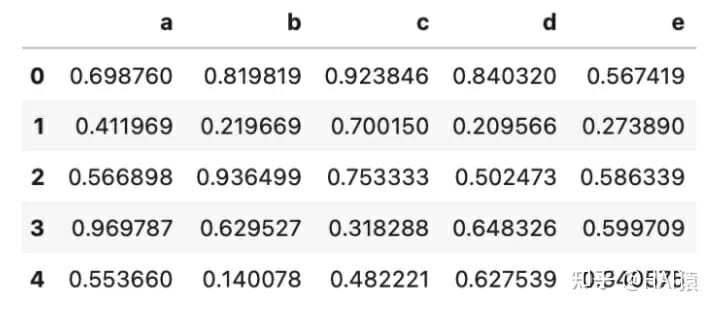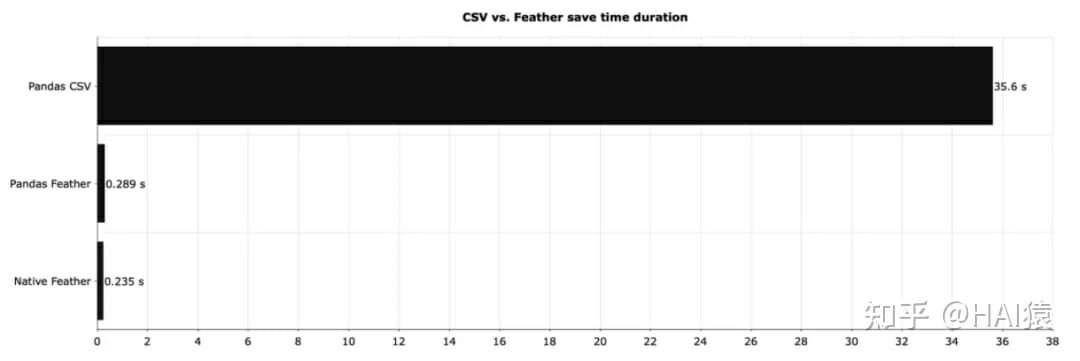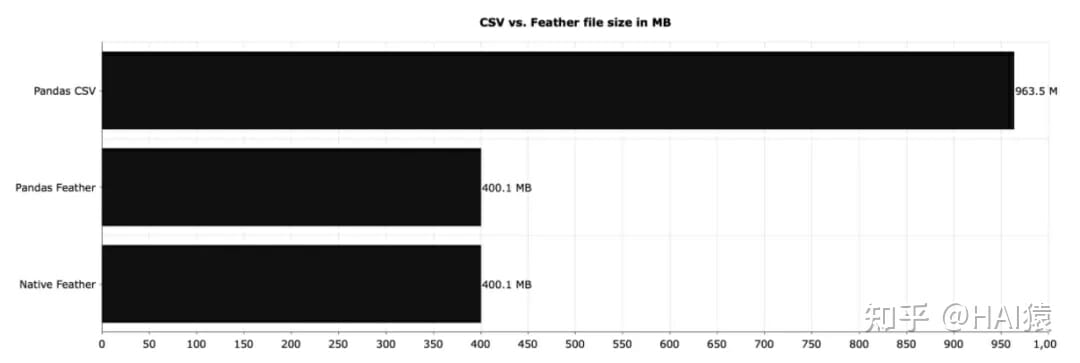再見CSV,速度提升150 倍!
最近上課時候發現老師在用一個我沒見過的數據格式,最主要的是速度很快,求教之後決定分享給大家,畢竟獨樂樂不如眾樂樂~~~

先介紹下為什麼要和其實也談不上徹底再見吧,日常還是要用的,這裡只是再介紹一個更加高效的數據格式。
用一是因為
雖然用
其實,今天和大家介紹一個
Feather是什麼?
Feather它最初是為了
現在
不過,要說明下,它的數據格式並不是為長期存儲而設計的,一般的短期存儲。
如何在Python中操作Feather?
在首先需要安裝
# pip # pip pip install feather -format # Anaconda conda install -c conda-forgefeather-format pip install feather -format # pip pip install feather -format # Anaconda conda install -c conda-forgefeather-format # Anaconda # pip pip install feather -format # Anaconda conda install -c conda-forgefeather-format
只需要上面一行安裝即可,很簡單。
我們通過一個較大的數據集舉例,需要數據集有5 列和1000 萬行隨機數。
import feather import feather import numpy as np import pandas as pd np.random.seed = 42 df_size = 10000000 df = pd.DataFrame({ 'a': np.random.rand(df_size), 'b': np.random.rand(df_size), 'c': np.random.rand(df_size), 'd': np.random.rand(df_size), 'e': np.random.rand(df_size) }) df.head() import numpy as np import feather import numpy as np import pandas as pd np.random.seed = 42 df_size = 10000000 df = pd.DataFrame({ 'a': np.random.rand(df_size), 'b': np.random.rand(df_size), 'c': np.random.rand(df_size), 'd': np.random.rand(df_size), 'e': np.random.rand(df_size) }) df.head() import pandas as pd import feather import numpy as np import pandas as pd np.random.seed = 42 df_size = 10000000 df = pd.DataFrame({ 'a': np.random.rand(df_size), 'b': np.random.rand(df_size), 'c': np.random.rand(df_size), 'd': np.random.rand(df_size), 'e': np.random.rand(df_size) }) df.head() np.random.seed = 42 import feather import numpy as np import pandas as pd np.random.seed = 42 df_size = 10000000 df = pd.DataFrame({ 'a': np.random.rand(df_size), 'b': np.random.rand(df_size), 'c': np.random.rand(df_size), 'd': np.random.rand(df_size), 'e': np.random.rand(df_size) }) df.head() df_size = 10000000 import feather import numpy as np import pandas as pd np.random.seed = 42 df_size = 10000000 df = pd.DataFrame({ 'a': np.random.rand(df_size), 'b': np.random.rand(df_size), 'c': np.random.rand(df_size), 'd': np.random.rand(df_size), 'e': np.random.rand(df_size) }) df.head() df = pd.DataFrame({ import feather import numpy as np import pandas as pd np.random.seed = 42 df_size = 10000000 df = pd.DataFrame({ 'a': np.random.rand(df_size), 'b': np.random.rand(df_size), 'c': np.random.rand(df_size), 'd': np.random.rand(df_size), 'e': np.random.rand(df_size) }) df.head() 'a': np.random.rand(df_size), import feather import numpy as np import pandas as pd np.random.seed = 42 df_size = 10000000 df = pd.DataFrame({ 'a': np.random.rand(df_size), 'b': np.random.rand(df_size), 'c': np.random.rand(df_size), 'd': np.random.rand(df_size), 'e': np.random.rand(df_size) }) df.head() 'b': np.random.rand(df_size), import feather import numpy as np import pandas as pd np.random.seed = 42 df_size = 10000000 df = pd.DataFrame({ 'a': np.random.rand(df_size), 'b': np.random.rand(df_size), 'c': np.random.rand(df_size), 'd': np.random.rand(df_size), 'e': np.random.rand(df_size) }) df.head() 'c': np.random.rand(df_size), import feather import numpy as np import pandas as pd np.random.seed = 42 df_size = 10000000 df = pd.DataFrame({ 'a': np.random.rand(df_size), 'b': np.random.rand(df_size), 'c': np.random.rand(df_size), 'd': np.random.rand(df_size), 'e': np.random.rand(df_size) }) df.head() 'd': np.random.rand(df_size), import feather import numpy as np import pandas as pd np.random.seed = 42 df_size = 10000000 df = pd.DataFrame({ 'a': np.random.rand(df_size), 'b': np.random.rand(df_size), 'c': np.random.rand(df_size), 'd': np.random.rand(df_size), 'e': np.random.rand(df_size) }) df.head() 'e': np.random.rand(df_size) import feather import numpy as np import pandas as pd np.random.seed = 42 df_size = 10000000 df = pd.DataFrame({ 'a': np.random.rand(df_size), 'b': np.random.rand(df_size), 'c': np.random.rand(df_size), 'd': np.random.rand(df_size), 'e': np.random.rand(df_size) }) df.head() }) import feather import numpy as np import pandas as pd np.random.seed = 42 df_size = 10000000 df = pd.DataFrame({ 'a': np.random.rand(df_size), 'b': np.random.rand(df_size), 'c': np.random.rand(df_size), 'd': np.random.rand(df_size), 'e': np.random.rand(df_size) }) df.head()

它的用法和之前
保存
兩種方式,一是
df.to_feather('1M.feather')二是用
feather.write_dataframe(df, '1M.feather')加載
加載也是一樣的,同樣還是兩種方式。一是通過
df = pd.read_feather('1M.feather')二是用
df =feather.read_dataframe('1M.feather')操作習慣一樣,難度完全沒有。
和CSV的區別
對比產生美。下面來看下下圖顯示了上面本地保存DataFrame 所需的時間:

差距巨大,有木有!原生如果使用
然後再看下讀取不同格式的相同數據集需要多長時間。

同樣,差異也很明顯。 CSV並且

CSV假如我們每天存儲千兆字節的數據,那麼選擇正確的文件格式至關重要。 Feather
當然,如果追求更多的壓縮空間,也可以試試
結語
說了這麼多,可能很多同學還是甩出一句話:這個東西怎麼說呢,當你需要它時,它就有用,如果日常沒有速度和空間的強烈需求,還是老老實實畢竟
我是猿子,一起起飛啊!



